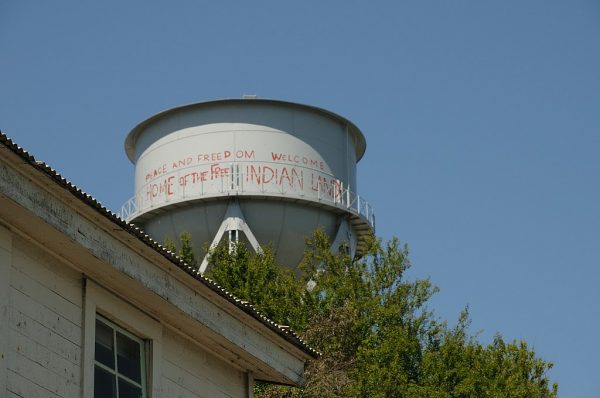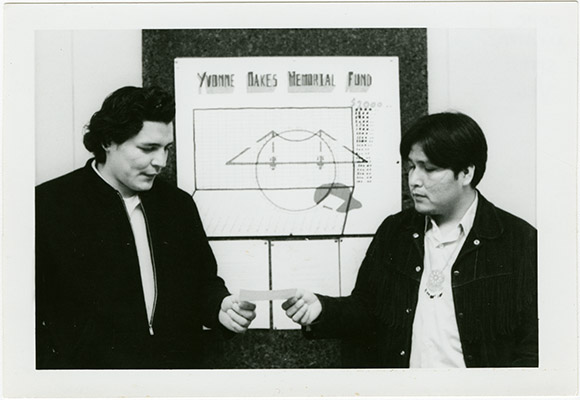An Introduction to Alcatraz
What would it look like if we tried to teach the history of the Civil Rights Movement without Dr. Martin Luther King Jr.? This was the question Dr. Kent Blansett raised at his recent presentation, “Think Indigenous,” on the Red Power Movement at the Public Lands History Center’s American West Program in November 2019. His query prompted me to start down the historical trail that resulted in this article, which is greatly indebted to Blansett’s thoughts on indigenization. On the 50th anniversary of the Indians of All Tribes’ occupation of Alcatraz island, the National Park Service is returning that event to public consciousness, and with it, activist Richard Oakes’ role in the occupation.[1] However, because this event is being remembered in the context of its anniversary, the occupation’s story is often publicly interpreted as a single event rather than as a link in the longer chain of Alcatraz’s Native American history.

The Ohlone, Colonial Claims and Imperial Control
Alcatraz’s history reflects patterns of colonial land claims and methods of cultural control that undergird Euro-American history. The island was originally part of the homelands of the Ohlone, or “‘western people’” in the Miwok language, as well as the Coast Miwok. The island was used to isolate people who broke tribal law as well as a place to camp and gather food.[2] Spanish colonization in the San Francisco Bay began in the 1770s. It relied on a three-pronged system of military, religious, and civilian arms to back up Spain’s claims to land and authority. Missionaries legally controlled Native peoples’ “persons, labor, and properties until they were ready for life in the secular settlements.” Native peoples responded to these assertions of control in a variety of ways including resistance, rebellion, relocation, cultural mediation, and voluntary engagement. While the mission system undeniably disrupted Native cultures and dispossessed people of their traditional lands, engaging with the missions and European culture equipped Native people to endure a changing world.[3]
As California entered the nineteenth century, things were changing faster than ever. Mexico won independence from Spain in 1821 and controlled California until unrest turned into revolts in the 1830s. The US seized control in 1846, and then tightened its grip on California’s land and its occupants of all races. The rush of Anglo-American settlers into California came at a steep cost to the land and lives of mixed-race, Hispanic, and Indigenous people.[4] Near Alcatraz, the US government stripped individual Coast Miwoks of land titles that had been formally recognized under Mexican rule. In the midst of the chaos, Indigenous peoples remained near present-day Marin and Sonoma counties, fighting for land and federal recognition into the twentieth century.[5] Today, the Coast Miwok are part of the Graton Rancheria, a federation of Coast Miwok and Southern Pomo groups located in Sonoma county.
Native Defiance in an Island Prison
The U.S. established a short-lived military fortification on Alcatraz Island in 1850 and later repurposed it as a military prison. The first description of Alcatraz as a prison dates from an 1874 letter. The adjutant general mentions that the island had been a “point for collecting prisoners,” since August 27, 1861.[6] The first Native American prisoners came to Alcatraz in 1873. The reasons the Army send prisoners to Alcatraz varied. It charged some with participating in plains warfare, murder, or mutiny, while others’ charges went unrecorded.[7] Paiute, Modoc, Chiricahua Apache, as well as other Native people with unknown affiliations were all imprisoned there over time. [8] In January 1895, the US Army imprisoned nineteen Hopi men of different clans from the town of Orayvi, Arizona, in retaliation for their resistance to the allotment of tribal lands and refusal to send children to government-run boarding schools. Like the Franciscan missions, Indian schools attempted to dismantle tribal identities, cultures, and languages and assimilate Native children into mainstream American society. The Hopis held at Alcatraz were sentenced to hard labor during their incarceration. They returned to Fort Defiance, Arizona, on September 23, 1895. On the condition that the men cease their resistance, the Army returned them home. As a tribe, the Hopis nevertheless continued efforts to retain their children and their land.[9]
Richard Oakes and the Indians of All Tribes Occupation

In 1934, Alcatraz transitioned again, and the site became a federal penitentiary until 1963. Afterwards, the federal government left the island vacant. The island became a focal point for Native American activism. Alcatraz was the site of shorter Native American occupations before Indians of All Tribes activists took over the island from 1969-1971.[10] At the occupation’s start, Akwesasne Mohawk Richard Oakes stood at the San Francisco harbor. From the center of a media frenzy, he offered to purchase the island from the U.S. government. He later swam through the bay’s chilling waters to stand on Alcatraz’s shore, claiming “The Rock” as Indian land in dramatic style.[11] The charismatic leader would shape the Red Power movement even after a tragic fall on the island claimed the life of his young daughter, causing him to leave Alcatraz with his family.
Following the occupation, Oakes was attacked multiple times before being gunned down in the street by a white nationalist. Within the court system, the shooter was charged with manslaughter and later acquitted. “My historical argument,” Blansett asserts, “is that Michael Oliver Morgan assassinated Richard Oakes.” Blansett’s need to exhaustively defend his rhetorical righting of a “travesty of justice and a failure of the American legal system” in print evidences how past unequal treatment of Native people before the law continues to hold consequences in the present day. Blansett urges historians to interpret Oakes’ killing critically. Not, he asserts, by simply reporting what the court decided at the time, but rather by analyzing the evidence and drawing their own conclusions with the advantage of historical perspective.[12]
Restoring Historical Linkages at Alcatraz
The NPS and others’ commemoration of the 1969 Alcatraz occupation is a step towards greater equity for Native Americans in public lands history and American public memory. However, the underlying issues that produced this anniversary have not been resolved. The violence surrounding the Water Protectors’ resistance to the Dakota Access Pipeline represents the most public and the most recent permutation of centuries of Euro-American attempts to claim Native land and control Native people.[13] At Alcatraz, Native Americans exercised agency as they acted and were acted upon by centuries of Euro-American colonization and displacement. Resistance to assaults on Native identities and ways of life on the island’s shores was not confined to the mid-twentieth century. Adding a few centuries to this story’s start, as well as several decades to its end, illustrates the repetitive nature of Euro-American attempts to control Native people and their land and demands that people in the present actively question that pattern and seek ways to disrupt it.
-Ariel Schnee, PLHC Program Manager
Published 02/06/2020
Sources
[1] “American Indian Occupation – 50th Anniversary,” National Park Service: Golden Gate National Recreation Area, https://www.nps.gov/goga/red-power-on-alcatraz.htm. Accessed November 19. 2019.
[2] Troy Johnson, “’We Hold the Rock:’ The Alcatraz Indian Occupation,” National Park Service: Alcatraz Island, https://www.nps.gov/alca/learn/historyculture/we-hold-the-rock.htm, Accessed November 18, 2019. And Randall Millikin, Ethnohistory and Ethnography of the Coast Miwok and their Neighbors, 1783-1840, National Park Service, Technical Paper, 2009, https://www.nps.gov/goga/learn/historyculture/upload/2009-Final-Coast-Miwok-Report.pdf, Accessed November 18, 2019.
[3] Richard B. Rice, William A. Bullough, and Richard J. Orsi, The Elusive Eden: A New History of California, Third Edition, Chapter 6, “Spanish California” (New York: McGraw Hill, 2002), 86-93, 100, 101.
[4] Ann F. Hyde, Empires, Nations, and Families: A New History of the North American West, 1800-1860, (Lincoln: University of Nebraska Press, 2011), 469.
[5] Randall Millikin, Ethnohistory and Ethnography of the Coast Miwok and their Neighbors, 1783-1840, National Park Service, Technical Paper, 2009, ii, https://www.nps.gov/goga/learn/historyculture/upload/2009-Final-Coast-Miwok-Report.pdf, Accessed November 18, 2019. And History, Federated Indians of Graton Rancheria, gratonrancheria.com, https://gratonrancheria.com/culture/history/, Accessed December 5, 2019.
[6] Erwin N. Thompson, “The Rock: A history Alcatraz Island, 1847-1972, Historic Resources Study, Golden Gate National Recreation Area California,” Denver Service Center: National Park Service, 265-267, https://www.nps.gov/alca/learn/photosmultimedia/upload/TheRock-web.pdf, Accessed November 18, 2019.
[7] “The Army and American Indian Prisoners: The Army and American Indian Prisoners on the Rock,” National Park Service: Alcatraz, https://www.nps.gov/alca/learn/photosmultimedia/upload/TheRock-web.pdf, Accessed November 18, 2019 and Erwin N. Thompson, “The Rock: A history Alcatraz Island, 1847-1972, Historic Resources Study, Golden Gate National Recreation Area California,” Denver Service Center: National Park Service, 296, https://www.nps.gov/alca/learn/photosmultimedia/upload/TheRock-web.pdf, Accessed November 18, 2019.
[8] “The Army and American Indian Prisoners: The Army and American Indian Prisoners on the Rock,” National Park Service: Alcatraz, https://www.nps.gov/alca/learn/photosmultimedia/upload/TheRock-web.pdf, Accessed November 18, 2019 and Erwin N. Thompson, “The Rock: A history Alcatraz Island, 1847-1972, Historic Resources Study, Golden Gate National Recreation Area California,” Denver Service Center: National Park Service, 296, https://www.nps.gov/alca/learn/photosmultimedia/upload/TheRock-web.pdf, Accessed November 18, 2019.
[9] Wendy Holliday, “Hopi History: The Story of the Alcatraz Prisoners,” National Park Service: Alcatraz Island, https://www.nps.gov/alca/learn/historyculture/hopi-prisoners-on-the-rock.htm, Accessed November 18, 2019. And Erwin N. Thompson, “The Rock: A history Alcatraz Island, 1847-1972, Historic Resources Study, Golden Gate National Recreation Area California,” Denver Service Center: National Park Service, 298-299, https://www.nps.gov/alca/learn/photosmultimedia/upload/TheRock-web.pdf, Accessed November 18, 2019.
[10] Kent Blansett, “Think Indigenous,” The American West Program, Colorado State University: Fort Collins, CO. Lecture. November 7, 2019.
[11] Kent Blansett, A Journey to Freedom: Richard Oakes, Alcatraz, and the Red Power Movement, (New Haven: Yale University Press, 2018), 1.
[12] Kent Blansett, A Journey to Freedom: Richard Oakes, Alcatraz, and the Red Power Movement, (New Haven: Yale University Press, 2018), 346.
[13] Allison Herrera, “Standing Rocky activists: Don’t call us protestors. We’re water protectors.” PRI.org, October 31, 2016. https://www.pri.org/stories/2016-10-31/standing-rock-activists-dont-call-us-protesters-were-water-protectors. Accessed November 19, 2019. And Tim Stelloh, Molly Roecker, Chiara A Sottile and Daniel A. Medina, “Dakota Pipeline: Protestors Soaked with Water in Freezing Temperatures,” MSNBC News, November 21, 2016. https://www.nbcnews.com/storyline/dakota-pipeline-protests/dakota-pipeline-protesters-authorities-clash-temperatures-drop-n686581. Accessed November 19, 2019.